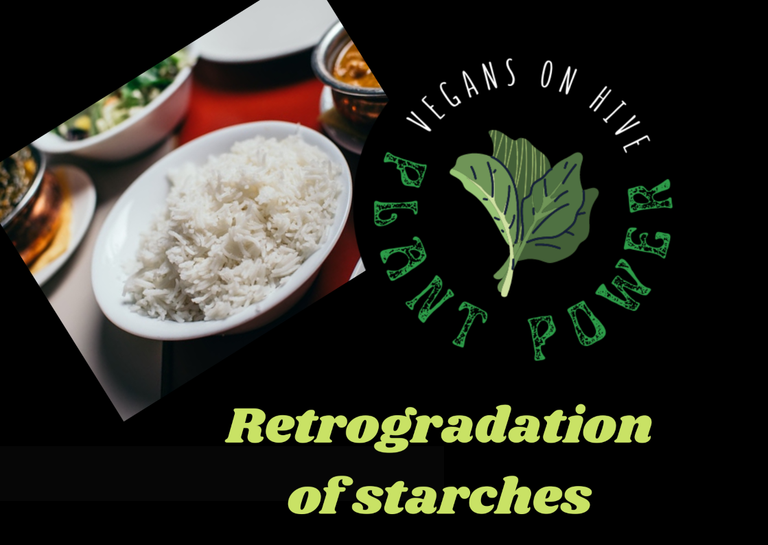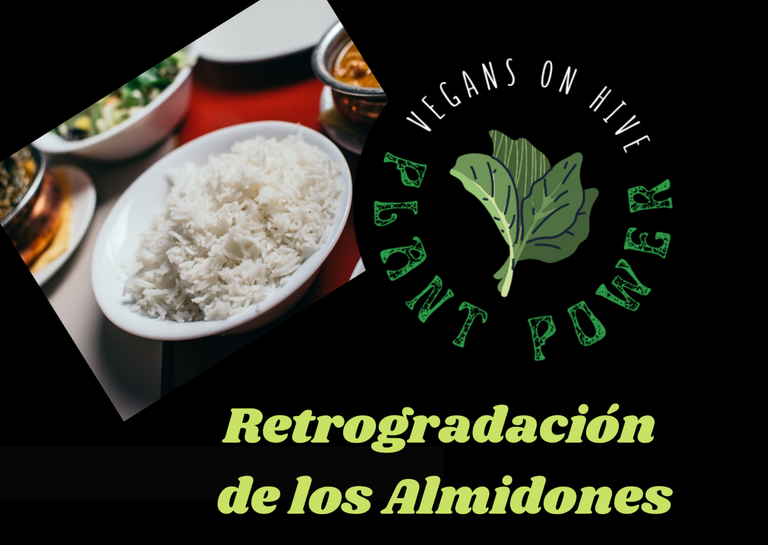
ENGLISH
Hello plant-based foodies, wherever you are in the world and/or galaxy!
Here @sirenahippie

Let's begin by defining starch. It is a complex carbohydrate or polysaccharide (made up of a large number of simple sugars, which in turn form glucose chains) that comes from plants and is an energy reserve for both plants and humans. Starches are stored by plants in roots, tubers, and seeds. They are a fundamental part of the human diet, and also have uses in industry and animal feed.

The sugars that make up starches are linked by hydrogen bridges or bonds. When they enter the human body, these bonds are broken by digestive enzymes, causing the simple sugars to become "free" and be absorbed in the intestine.

Now, when RETROGRADATION OF STARCHES occurs, which is possible by subjecting starches for hours to low temperatures, the molecules that form these foods realign and the hydrogen bonds that join simple sugars multiply, generating what is known as RESISTANT STARCHES, that is, when there are more hydrogen bonds, these starches do NOT break down into simple sugars, and can NOT be absorbed by the human body, becoming FIBER (which will then be excreted in the feces), which in turn serves as a substrate for intestinal bacteria to do their work, that is, they become PREBIOTIC elements.

Aside from this biochemical explanation, which may seem complex to some readers (we've tried to keep it as simple as possible), STARCH RETROGRADATION can be done very easily: It is only necessary to refrigerate the starches for 24 hours and in adequate conditions before consuming them; for example: Rice, pasta, breads, cakes, potatoes, cassava, etc. In this way, the starches become resistant, and therefore healthier, since the human body will not be able to assimilate the sugars present in them. This is very useful if you want to lose weight or control blood sugar levels, as is the case with diabetics. But remember, this process IS NOT A PANACEA.

Starch retrogradation is a simple process that can provide many health benefits, but it is not a single solution to obesity, diabetes, or any other similar disease. It requires other actions, including medical supervision. We hope this information is useful, and that those interested in taking care of their health will put this process into practice


ESPAÑOL

¡Hola amantes de los alimentos basados en plantas, donde quiera que estén en el mundo y/o la galaxia!
Aquí @sirenahippie

Comenzaremos definiendo qué es un ALMIDÓN. Es un hidrato de carbono complejo o polisacárido, (conformado por un gran número de azúcares simples, que a su vez forman cadenas de glucosa), que proviene de los vegetales, y es una reserva energética tanto para las plantas como para los seres humanos. Los almidones son almacenados por las plantas en las raíces, tubérculos y semillas. Forman parte fundamental de la dieta del ser humano, como también tiene usos a nivel industrial y dentro de la alimentación animal.

Los azúcares que componen a los ALMIDONES, se unen por puentes o enlaces de hidrógeno. Cuando ingresan al cuerpo humano, estos enlaces son rotos por las enzimas digestivas, haciendo que los azúcares simples queden “libres” y son absorbidos a nivel intestinal.

Ahora bien, cuando ocurre la RETROGRADACIÓN DE LOS ALMIDONES, lo cual es posible al someter a los almidones por horas a bajas temperaturas, las moléculas que forman estos alimentos se realinean y, los enlaces de hidrógenos que unen a los azúcares simples, se multiplican, generando lo que se conoce como ALMIDONES RESISTENTES, es decir, que al existir más enlaces de hidrógeno, estos almidones NO se descomponen en azúcares simples, y NO pueden ser absorbidos por el cuerpo humano, convirtiéndose en FIBRA (que luego será excretada en las heces), que a su vez sirve de sustrato para que las bacterias intestinales puedan hacer su trabajo, es decir, se convierten en elementos PREBIÓTICOS.

Al margen de esta explicación bioquímica, que puede resultar compleja para algunos lectores (intentamos hacerla lo más simple posible), la RETROGRADACIÓN DE LOS ALMIDONES, puede hacerse de forma muy sencilla: Sólo es necesario refrigerar por 24 horas y en condiciones adecuadas, los almidones antes de consumirlos; por ejemplo: Arroz, pasta, panes, tortas, papas, mandioca, etc. De esta forma, los almidones se vuelven resistentes, y por tanto más saludables, pues el organismo humano no podrá asimilar los azúcares presentes en ellos. Esto es muy útil si deseas bajar de peso o controlar los niveles de azúcar en sangre, como es el caso de las personas diabéticas. Pero recuerden, este proceso NO ES UNA PANACEA.

La RETROGRADACIÓN DE LOS ALMIDONES es un proceso sencillo, que puede brindar muchos beneficios para la salud, pero que por sí mismo no es una solución única a la obesidad, la diabetes o a cualquier otra enfermedad similar, pues se requieren otras acciones, e incluso, control médico para ello. Esperamos que esta información sea de utilidad, y aquellos que estén interesados en cuidar su salud, pongan en práctica este proceso

BIBLIOGRAPHY / BIBLIOGRAFÍA

RELATED POSTS / POSTS RELACIONADOS
Vegetables and fruits: Pumpkin / Verduras y frutas: Calabaza (ENG / SPN)
Ideas for starting a vegan diet / Ideas para iniciar una alimentación vegana (ENG / SPN)
Vegan substitutes / Sustitutos veganos (ENG / SPN)
Vegetarian eating styles / Estilos de alimentación vegetariana (ENG / SPN)


Delegations welcome!
